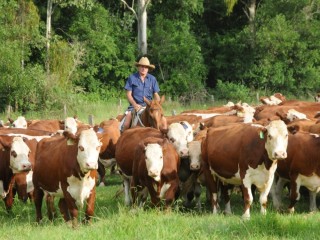 Beef producers will be issued with a ‘friendly reminder’ tomorrow to be vigilant over withholding periods and slaughter intervals on animals treated with certain animal health products, following a drug residue detection above accepted limits in Australian beef in Russia.
Beef producers will be issued with a ‘friendly reminder’ tomorrow to be vigilant over withholding periods and slaughter intervals on animals treated with certain animal health products, following a drug residue detection above accepted limits in Australian beef in Russia.
Safemeat secretariat spokesman Ed Klim this afternoon confirmed that a single detection had occurred in Russia several months ago in Australian beef for tetracycline, at “incredibly low levels”.
“Russia takes a very strict line on maximum residue limits for this antibiotic – we’re talking parts per billion – which are much more severe than most other countries,” Mr Klim said.
“Because Russia is an important and growing market for Australian beef, Safemeat and the industry is taking the initiative of issuing a warning to reinforce the vigilance message, to reduce the risk of any more detections occurring.”
In research after the detection was made, Safemeat had analysed ten years’ worth of randomly sampled data from Australia’s National Residue Survey program, numbering about 11,000 cattle samples. Just six ‘traces’ of tetracycline had been identified, all below MRLs.
“But when you start looking at analytical methods identifying extremely small numbers, like parts per billion, then obviously we can run into trouble,” Mr Klim said.
While Australia followed the CODEX international standard on MRLs for tetracycline, Russia’s threshold was significantly lower, he said.
There was nothing particularly unusual in certain countries adopting standards other than that set by CODEX, and nations like Japan, the US and even Australia all maintained MRLs that did not follow the international prescription on some chemicals, for various reasons.
The decision by Safemeat to issue a producer update after a single residue violation was no different from earlier warnings during plague locust spraying, endosulfan use or other issues as they had arisen, Mr Klim said.
“It’s a proactive, preventative approach, designed to avoid any further issue in international markets,” he said.
The advice to producers is expected to include information about MRLs and Withholding Periods, and how to manage treated animals, as well as correct procedures when filling out National Vendor Declarations for treated animals.
According to Wikipedia, tetracyclines are a group of broad-spectrum antibiotics whose general usefulness has been reduced with the onset of bacterial resistance. Despite this, they remain a treatment of choice for some applications, generally used in the treatment of respiratory and similar infections.
Safemeat is a partnership between the red meat and livestock industry and the state and federal governments of Australia. It ensures that Australian red meat and livestock products achieve the highest standards of safety and hygiene from the farm to the consumer. The organisation also initiates R&D, develops communication linkages, monitors the status of Australia’s products, reviews standards and examines emerging issues that could have an impact on the industry in the future.
- The full Safemeat advice to beef producers issued just minutes ago is published in full below. It has also been posted on the Safemeat website.
IMPORTANT ADVICE FOR LIVESTOCK PRODUCERS
LPA NVD REQUIREMENTS – EFFECTIVE 1/1/2012 FOR RUSSIAN MARKET ACCESS
Detection of oxytetracycline or chlortetracycline residues in meat or offal in Russia will result in the meat processor, and potentially Australia, being banned from that market. Russia is Australia’s fourth most important market.
To meet Russian market access requirements SAFEMEAT is implementing a 90 day Provisional Russian Export Slaughter Interval (ESI) for products and feed containing oxytetracycline or chlortetracycline – effective 1 January 2012.
Producers must now declare the status of their livestock against this ESI by correctly completing the LPA NVD.
MARKETING LIVESTOCK AS ‘RUSSIAN ELIGIBLE’
If you do not use products or feed containing oxytetracycline or chlortetracycline you must write the words ‘Russian Eligible’ on the LPA NVD. Use Question 9 for cattle and Question 7 for sheep.
If you use products or feed containing oxytetracycline or chlortetracycline and comply with the 90 day Provisional Russian Export Slaughter Interval you must write the words ‘Russian Eligible’ on the LPA NVD. Use Question 9 for cattle and Question 7 for sheep.
Where ‘Russian Eligible’ is written on the LPA NVD it means that the livestock have not been injected with or ingested feed products containing oxytetracycline and chlortetracycline in the last 90 days.
OBSERVE ‘BEST PRACTICE’ DRUG ADMINISTRATION
If you use products containing oxytetracycline or chlortetracycline you must:
• Follow label instructions accurately,
• Administer the treatment in the upper neck region only, as per label instructions.
WHEN CAN’T LIVESTOCK BE MARKETED AS ‘RUSSIAN ELIGIBLE’?
Do not write the words ‘Russian Eligible’ on the LPA NVD if livestock have been injected or fed with products containing oxytetracycline and/or chlortetracycline in the last 90 days.
MORE INFORMATION?
Animal health treatments containing oxytetracycline or chlortetracycline are being assessed for lower slaughter intervals, and when available will be published on the SAFEMEAT website
For the latest updates, including a list of products containing oxytetracycline or chlortetracycline, go to the SAFEMEAT website or contact your veterinarian.
